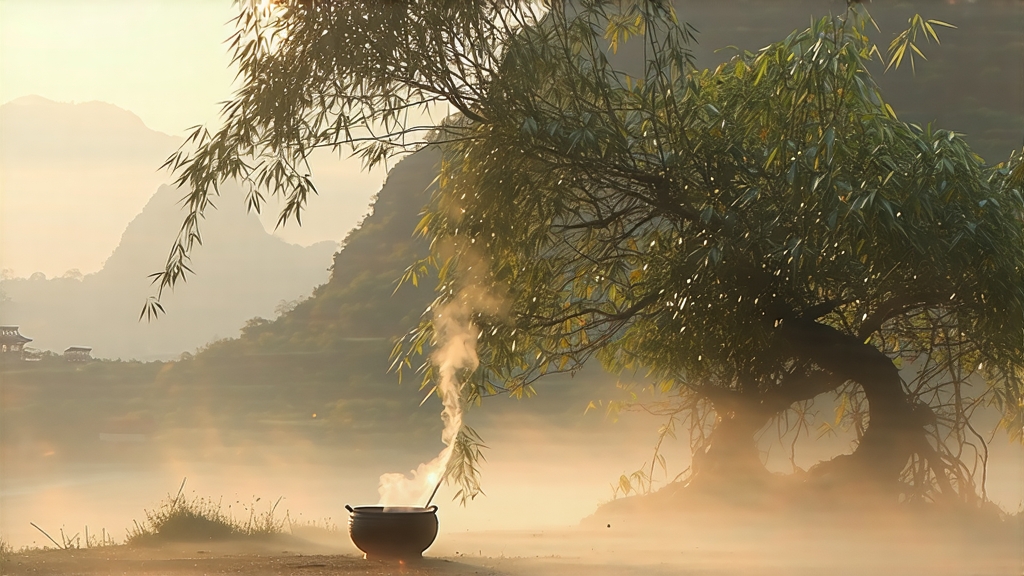
Tucked high on the northern rim of the Sichuan Basin, Meng Ding Mountain has been sending clouds to kiss its granite cliffs for more than two millennia. Among the mists and prayer flags lives a tea so shy that even seasoned drinkers walk past it without notice: Meng Ding Huang Ya, literally “the yellow bud of Meng Ding.” Unlike the flamboyant Dragon Well or the smoky Lapsang, this yellow tea speaks in whispers, and its story is written in the language of humidity, patience, and almost-lost craft.
Historical scrolls from the Western Han dynasty record that the Daoist monk Wu Lizhen planted seven tea bushes on the summit in 53 BCE, believing the plants would capture the mountain’s “immortal qi.” By the Tang dynasty those bushes had become state property; every spring their first four leaves were carried by fast horse to Chang’an for the emperor’s ancestral rites. The Song “Cha Jing” already distinguishes “Meng Ya” as a separate tax category, and the Ming “Imperial Code” fixes the levy at 360 jin—no more, no less—because the court feared that over-picking would anger the mountain spirits. When Qing merchants shifted their taste to green tea, yellowing techniques were abandoned; by 1949 only three ageing artisans still remembered the full process. The 1979 restoration project had to reconstruct the recipe from a single handwritten note found inside a brick of a demolished monastery wall. Today the cultivar is protected under China’s GI law, and the annual yield is smaller than a single Bordeaux château.
The plant itself is a local variant of Camellia sinensis var. sinensis, nicknamed “old-men eyebrows” because the leaf tips curve downward like the long white brows of mountain sages. Grafted onto 300-year-old trunks, the bushes sit at 1,400–1,550 m where diurnal temperature swings reach 15 °C, locking in high levels of theanine while keeping catechins gentle. The soil is a coarse sandy loam derived from weathered granite; drainage is so rapid that roots are forced to dive three metres, absorbing trace selenium that gives the finished tea its faint sweet-metal note.
Plucking begins on the first Tuesday after the Qingming festival, when morning fog lingers until 10 a.m. Only the “sparrow tongue” standard—one unopened bud flanked by two leaves half-open—is accepted. Pickers wear cotton gloves to avoid fingerprint oils; leaves are dropped into bamboo tubes lined with wet parchment so they never see direct sunlight. Within 30 minutes the harvest is carried downhill in wicker backpacks suspended from the forehead, a balancing act that keeps the cargo vertical and prevents the delicate hairs from breaking.
The craft that turns green leaf into yellow is called “sealed yellowing” (men huang), a slow enzymatic waltz conducted without a single turn of the compost pile. First comes a 3-minute “kill-green” at 160 °C on a Meng-style bamboo-rope wok; the leaf must reach 68 °C core temperature yet remain 55 % moist. While still hot, it is wrapped in double-layered kraft paper and slid into a hemp-lined cedar box. Every two hours the bundle is opened, aired for 90 seconds, re-wrapped, and returned to the box. This breathing cycle continues for 60–72 hours, during which chlorophyll quietly degrades into pheophytin, polyphenols oxidise just 5–7 %, and a hay-like aroma drifts through the workshop. Finally the leaf is given a gentle charcoal bake at 45 °C for six hours, then rested for ten days so the remaining moisture migrates from stem to tip. The result is a leaf the colour of old ivory, with a downy surface that feels like peach skin.
Western tea charts often lump yellow tea with green, but the chemistry tells a different story. The sealed yellowing step pushes the theanine-to-catechin ratio to 1:1.3, compared with 1:2.1 in green tea, creating a brothy sweetness that lingers on the lateral tongue. Volatiles include lilac aldehyde and trans-β-ionone, compounds normally found in oolong, yet the absence of leaf bruising keeps the texture silk-smooth. Caffeine drops 12 % because the extended wrap encourages microbial demethylation, giving Meng Ding Huang Ya the rare gift of calm alertness.
To brew it respectfully, use neutral water—TDS 40–60 ppm, pH 7—heated to 85 °